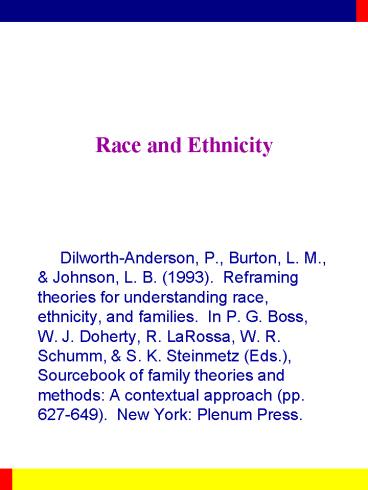Race and Ethnicity - PowerPoint PPT Presentation
1 / 11
Title:
Race and Ethnicity
Description:
Three Approaches to Value Intrusion in Social Science: ... Value separation: approach social science as if it is possible to separate ... – PowerPoint PPT presentation
Number of Views:40
Avg rating:3.0/5.0
Title: Race and Ethnicity
1
Race and Ethnicity
- Dilworth-Anderson, P., Burton, L. M.,
Johnson, L. B. (1993). Reframing theories for
understanding race, ethnicity, and families. In
P. G. Boss, W. J. Doherty, R. LaRossa, W. R.
Schumm, S. K. Steinmetz (Eds.), Sourcebook of
family theories and methods A contextual
approach (pp. 627-649). New York Plenum Press.
2
Definitions
- Race
- Cultural construction of identity based on social
description. - From this perspective, race has a cultural
reality. - Ethnicity
- An experientially based identity that is part of
an ongoing process. - It is part of the social self which contributes
to a personal sense of peoplehood as well as a
sense of shared identity with others form the
same group.
3
Definitions (cont.)
- Minority group
- Any collective of people (e.g., women,
Native-Americans, African-Americans,
Hispanic-Americans) that is assigned a low social
position. - This low social position reflects oppression,
suppression, and discrimination that is
experienced in almost all aspects of life. - Culture a subjective and objective expression of
self which represents the encompassing aspects of
a persons life it includes racial and ethnic - rituals
- symbols
- language
- general patterns of behavior.
4
Impact of Assumptions, Values, and Ethnic Reality
- From age four, European-American children hold
negative attitudes toward other groups (Aboud,
1987) which are reinforced at all levels (e.g.,
from parents, media, teachers) (Phinney
Rotheram, 1987). - Values and scientific truths are confused when
scholars uncritically use their personal cultural
frameworks to define and report on a culture
other than their own.
5
Three Approaches to Value Intrusion in Social
Science
- Value rejection suggest that social scientists
can be objective so values do not influence
theory and research. - Value separation approach social science as if
it is possible to separate values from research
and theory. - Value espousal scholars should clearly
articulate their values so that readers may
understand the complete nature of the research.
6
Example of Research Which Reflects Bias
- Moynihan (1965), a European-American
- Described deterioration of African-American
families. - Suggested that social policies should be
developed which would change their inferior
values and structure. - Hill (1972), an African-American
- Observed the resilience of African-American
families. - Recommended social policies which would build on
these strengths.
7
Dimensions Which Influence Thinking About
Diversity
- Social climate and social change influence theory
(e.g., genetic pathology versus cultural
relativity), research, and practice. - Presence of minorities in studies of the family
and method of group comparison. - Definition of the family (e.g., nuclear versus
extended blood relationship versus other
networks known as fictive kin).
8
Creating New Ways of Thinking
- Adopt a multi-disciplinary perspective in order
to avoid discipline-bound truths. - Identify and use culturally relevant concepts
examine various methodologies to understand
minority families examine culture and
experiences expressed through - art,
- music,
- dance,
- literature,
- and folktales.
9
Cultural Relevance in Existing Theory
- The Life Course Perspective
- Strengths for studying diversity
- It is based on an interdisciplinary way of
thinking. - It is flexible and dynamic, focusing on the
interlocking nature of individual trajectories,
re - temporal motion
- culture
- social change
- Modified perspective Kin-scripts framework
reviews - temporal and interdependent dimensions of role
transitions - transmission of family norms
- process of negotiation and reciprocity
10
Cultural Relevance in Existing Theory (cont.)
- Family Stress Theory
- Limited attempts to make this approach culturally
relevant. - Suggestions to enhance cultural relevance
- Recognize that minority families emphasize
survival over adaptation adaptation is a
fundamental theme in family stress theory. - Survival suggests an ongoing struggle to maintain
psychosocial balance without loss of identity.
11
Cultural Relevance in Existing Theory (cont.)
- Feminist Ideology
- Some scholars (e.g., Collins, 1990 Giddings,
1984 La Rue, 1970) dispute a central feminist
assumption they object to the tenet that women
are oppressed. - Rather, these scholars suggest that opportunities
for women are restricted, suggesting that they
experience suppression. - Distinction between terms
- Oppression refers to almost total restriction
from access to benefits, rights, and privileges
in society. - Suppression refers to a lesser degree of
restriction.































